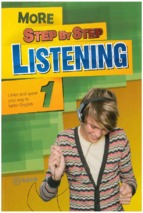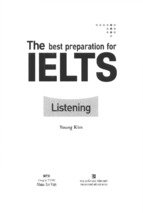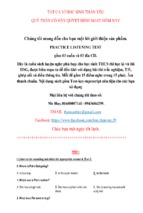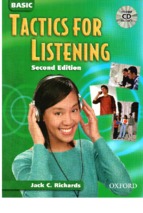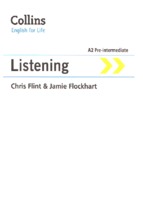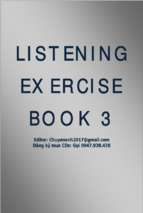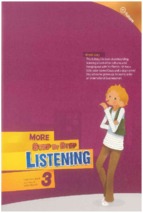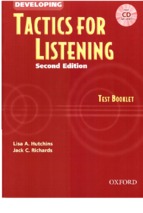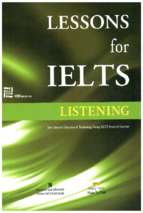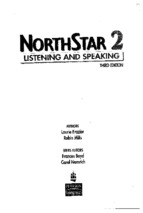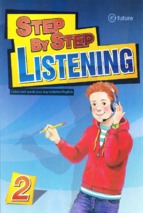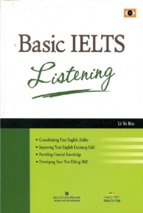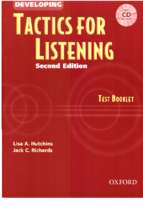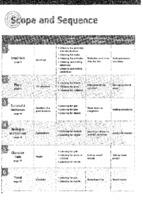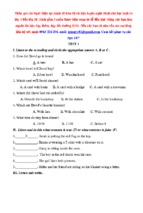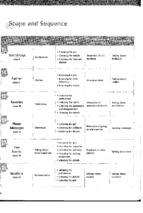ACADEMIC LISTENING AND SPEAKING
2
Contents
Answer Key. . . . . . . . . . . . . . . . . . . . . . . . . . . . . . . . . . . . . . . . . . . . . . . . . . . . 1
Assessment Tests
Test 1 . . . . . . . . . . . . . . . . . . . . . . . . . . . . . . . . . . . . . . . . . . . . . . . . . . . . . . 13
Test 2 . . . . . . . . . . . . . . . . . . . . . . . . . . . . . . . . . . . . . . . . . . . . . . . . . . . . . . 14
Test 3 . . . . . . . . . . . . . . . . . . . . . . . . . . . . . . . . . . . . . . . . . . . . . . . . . . . . . . 15
Test 4 . . . . . . . . . . . . . . . . . . . . . . . . . . . . . . . . . . . . . . . . . . . . . . . . . . . . . . 16
Transcripts
Chapter 1 . . . . . . . . . . . . . . . . . . . . . . . . . . . . . . . . . . . . . . . . . . . . . . . . . . 17
Chapter 2 . . . . . . . . . . . . . . . . . . . . . . . . . . . . . . . . . . . . . . . . . . . . . . . . . . 18
Chapter 3 . . . . . . . . . . . . . . . . . . . . . . . . . . . . . . . . . . . . . . . . . . . . . . . . . . 20
Chapter 4 . . . . . . . . . . . . . . . . . . . . . . . . . . . . . . . . . . . . . . . . . . . . . . . . . . 22
Chapter 5 . . . . . . . . . . . . . . . . . . . . . . . . . . . . . . . . . . . . . . . . . . . . . . . . . . 24
Chapter 6 . . . . . . . . . . . . . . . . . . . . . . . . . . . . . . . . . . . . . . . . . . . . . . . . . . 27
Chapter 7 . . . . . . . . . . . . . . . . . . . . . . . . . . . . . . . . . . . . . . . . . . . . . . . . . . 29
Chapter 8 . . . . . . . . . . . . . . . . . . . . . . . . . . . . . . . . . . . . . . . . . . . . . . . . . . 31
Chapter 9 . . . . . . . . . . . . . . . . . . . . . . . . . . . . . . . . . . . . . . . . . . . . . . . . . . 34
Chapter 10 . . . . . . . . . . . . . . . . . . . . . . . . . . . . . . . . . . . . . . . . . . . . . . . . . 36
Chapter 11 . . . . . . . . . . . . . . . . . . . . . . . . . . . . . . . . . . . . . . . . . . . . . . . . . 38
Chapter 12 . . . . . . . . . . . . . . . . . . . . . . . . . . . . . . . . . . . . . . . . . . . . . . . . . 41
1
prior written permission of Oxford University Press, with the sole exception
of photocopying carried out under the conditions described below.
198 Madison Avenue
New York, NY 10016 USA
The Publisher grants permission for the photocopying of those pages marked
“photocopiable” according to the following conditions. Individual purchasers
may make copies for their own use or for use by classes they teach. School
purchasers may make copies for use by their staff and students.
Great Clarendon Street, Oxford ox2 6dp UK
Oxford University Press is a department of the University of Oxford.
It furthers the University’s objective of excellence in research, scholarship,
and education by publishing worldwide in
Oxford New York
Auckland Cape Town Dar es Salaam Hong Kong Karachi
Kuala Lumpur Madrid Melbourne Mexico City Nairobi
New Delhi Shanghai Taipei Toronto
With offices in
Argentina Austria Brazil Chile Czech Republic France Greece
Guatemala Hungary Italy Japan Poland Portugal Singapore
South Korea Switzerland Thailand Turkey Ukraine Vietnam
oxford and oxford english are registered trademarks of
Oxford University Press
© Oxford University Press 2006
You must not circulate this book in any other binding or cover
and you must impose this same condition on any acquirer.
Any websites referred to in this publication are in the public domain and
their addresses are provided by Oxford University Press for information only.
Oxford University Press disclaims any responsibility for the content.
Executive Publisher: Janet Aitchison
Senior Aquisitions Editor: Pietro Alongi
Editor: Rob Freire
Associate Editor: Scott Allan Wallick
Art Director: Maj-Britt Hagsted
Production Manager: Shanta Persaud
Production Controller: Robin Roberson
Database right Oxford University Press (maker)
isbn-13: 978 0 19 441775 4
isbn-10: 0 19 441775 1
All rights reserved. No part of this publication may be reproduced, stored in a
retrieval system, or transmitted, in any form or by any means, without the
Printed in Hong Kong
10 9 8 7 6 5 4 3 2 1
Answer Key
Chapter 1
Environmental Studies
2 Listening Practice
A Preparing to Listen
Exercise 2 (p. 2)
2.
3.
4.
5.
suburbs
inner cities
decline
revitalize
B Focus on the Listening Skill
2.
3.
4.
5.
6.
7.
8.
Exercise 2 (p. 3)
Answers will vary.
building, commute, diversity, downtown, housing,
growth, residential, suburbs
D Thinking and Speaking (p. 7)
Photo a: bad seating and a lack of activities
Photo b: entrance exposed to wind and sun
Photo c: a path that leads nowhere
C Listening for the Main Idea (p. 3)
a. 4
b. 1
c. 2
d. 3
5 Pronunciation
Exercise 2. (p. 8)
example, park, playground, one, fountain, middle,
nice, there, together, water, safe, play, summer,
seating, both, more, go
D Listening for More Detail (p. 4)
1. a
2. a
3. b
4. a
5. b
6. a
7. b
8. a
7 Speaking Skills
3 Vocabulary
Exercise 3 (p. 9)
Exercise 1 (p. 5)
business district, City Hall, Opera House, shopping
area, department stores, sidewalk cafes, rush hour,
subway station.
Exercise 2 (p. 5)
2. mall
3. stop
4. building
2.
3.
4.
5.
6.
Chapter 4
Chapter 6
Chapter 5
Chapter 12
Chapter 7
Chapter 2
Psychology
B Listening for Main Ideas (p. 6)
a. ✓
5. park
6. market
4 Listening Practice
graffiti, or is just a green space with nothing to
attract people
Museums, a zoo, an outdoor theater, a skating
rink, playgrounds
To provide more reasons for people to go to a
place
Food
Women and elderly people
There’s not enough seating, or it’s uncomfortable,
or it’s out in the wind or the sun
So that people can see what’s inside and don’t feel
afraid to enter
Paths that don’t lead anywhere, or don’t go where
people want to go
c. ✓
d. ✓
2 Listening Practice
B Listening for Main Ideas (p. 11)
1. a
2. b
3. b
C Listening for More Detail (p. 7)
1. A park that is not successful is not used or is for
criminal activity, is usually empty, has litter and
Open Forum 2: Answer Key �
C Listening for More Detail (p. 12)
1. T
2. F
3. T
4. T
5. T
6. F
7. F
8. T
E Focus on the Listening Skill
Exercise 2 (p. 13)
1.
2.
3.
4.
5.
Chapter 1
Chapter 4
Chapter 5
Chapter 7
Chapter 8
Exercise 1 (p. 15)
When adding -ion to a word ending in e, the e is
dropped.
1. People say they experience deep feelings of
concentration and enjoyment.
2. Many people experience relaxation.
Exercise 2 (p. 13)
noun (with -ion) noun (with -ation) noun (with -ment)
connection
preparation
requirement
contribution
combination
retirement
discussion
organization
development
motivation
exploration
management
participation
achievement
I usually play the guitar at least three times a week. I
play in a group with friends and I play by myself too.
Exercise 2 (p. 16)
1.
2.
3.
4.
relaxation
contribution
discussion
motivation
5.
6.
7.
8.
achievement
preparation
requirement
indication
4 Listening Practice
B Listening for Main Ideas (p. 14)
1.
2.
3.
4.
Julia: driving, playing guitar
Leo: working on computers, socializing
Annie: participating in sports, coaching sports
Robert: doing dishes, fixing up his house,
bicycling
C Listening for More Detail (p. 14)
Julia
1. an hour and a half
2. listen to the radio or music
3. three times
4. with friends and alone
Leo
1. very little
2. plays computer games
� Open Forum 2: Answer Key
1.
2.
3.
4.
5.
an
a
the
and
for
6.
7.
8.
9.
10.
and
to
at
with
to
6 Speaking Skills
Exercise 1 (p. 16)
Annie says more than just “Yes” or “No.” Saying
more than just “Yes” or “No” helps keep conversation
going.
Exercise 3 (p. 13)
3. computer game
4. likes
Annie
1. many
2. team and individual sports
3. coach
4. sometimes
Robert
1. relaxing
2. finds solutions to problems
3. is stressful
4. enjoys bicycling
5 Pronunciation
Exercise 1 (p. 13)
3 Vocabulary
Exercise 2 (p. 16)
Answers will vary.
Chapter 3
Food Science
2 Listening Practice
B Listening for Main Ideas
1. ✓
2. ✓
4. ✓
6. ✓
C Listening for More Detail (p. 20)
1. c
2. c
3. b
4. b
5. a
6. c
3 Vocabulary
Exercise 1 (p. 22)
Where to have tea and coffee
7. b
8. c
Exercise 2 (p. 22)
would love, prefer, don’t feel like, would like, want,
can’t stand, don’t mind
Chapter 4
Visual Art
Exercise 3 (p. 22)
2 Listening Practice
A Preparing to Listen
2.
3.
4.
5.
6.
having/to have
getting
eating
to eat
eating/to eat
4 Listening Practice
B Listening for Main Ideas (p.23)
1. ✓
4. ✓
3. ✓
6. ✓
C Listening for More Detail (p. 23)
Answers will vary.
1. People eat out much more nowadays.
2. People, especially kids, used to drink a lot more
milk. Now they drink twice as much soda.
3. If people have more income, they eat out more.
4. There will be greater demand for variety.
5. Immigration affects the variety of food available,
including types of restaurants.
6. People will ask more for quality, rather than just
quantity.
5 Pronunciation
Exercise 1 (p. 24)
1.
2.
3.
4.
Wh
Y/N
Wh
Y/N
1. b
2. c
3. b
4. e
5. a
B Focus on the Listening Skill (p. 28)
a. ✓
c. ✓
e. ✓
C Listening for More Detail (p. 29)
1. a
2. b
3. c
4. c
5. b
6. a
7. c
8. a
3 Vocabulary
Exercise 1 (p. 30)
types of painting: (portrait), landscape
words to describe a painting: (realistic), abstract,
colorful, traditional, calm
things in a painting: (lines), dots, circles, shapes,
symbols, figures, scene, detail
location: (in the corner), in the foreground, in the
center, in the background
4 Listening Practice
B Listening for Main Ideas (p. 32)
a. ✓
c. ✓
e. ✓
C Listening for More Detail
Exercise 2 (p. 25)
Exercise 2 (p. 28)
2. a
6 Speaking Skills
Exercise 1 (p. 25)
The person is trying to eat more fruits and vegetables
and gave up chocolate for a while.
Exercise (p. 25)
Hmm, Let me think, Well, Let’s see
Exercise 1 (p. 32)
Answers will vary.
1. it’s imitated/copied a lot in popular culture
2. 1930
3. Dutch and German art/16th century Dutch
portraits
4. the style of the window in the house
5. Wood’s sister and his dentist
6. the 1890’s
7. unfriendly/not welcoming/suspicious
8. farmers/country people/people in small towns
Exercise 2 (p. 32)
a. 3
d. 2
b. 6
e. 5
c. 4
f. 1
Open Forum 2: Answer Key �
5 Pronunciation
Exercise 3 (p. 33)
1.
2.
3.
4.
5.
He was an American painter.
His sister was probably the model.
It’s a famous photograph.
Who is the woman supposed to be?
It’s a bit of a mystery.
6 Speaking Skills
Exercise 1 (p. 34)
The spoken version has more imprecise expressions.
Exercise 2 (p. 34)
2. sort of
3. kind of
4. It’s like
5. kind of
6. It’s as if
7. or something
2 Listening Practice
A Preparing to Listen (p. 37)
Answers will vary.
Oceans: fish, coral, whales, crab, beach, sand, snail
Medicine: prescription drugs, cancer, human disease,
bacteria, painkiller, anatomy, heart disease
Both: bacteria
B Listening for Main Ideas (p. 38)
c. 6
d. 1
e. 2
f. 5
C Listening for More Detail (p. 39)
1. More than half
2. 71%
3. Researchers are hoping to learn more about how
their eyes work to help learn more about eye
disease in humans.
4. They have new technologies that allow them to
go deeper into the oceans than before.
5. In the 1950s
6. It can swim incredibly fast.
D Focus on the Listening Skill
Exercise 1 (p. 39)
2. a
Because of “derived from the sea” before it
Exercise 2 (p. 40)
1. b
3 Vocabulary
Exercise 1 (p. 40)
careful, useful, hopeful
Exercise 2 (p. 41)
2.
3.
4.
5.
6.
7.
8.
9.
10.
Life Science
a. 4
b. 3
5. a
useful
beautiful
hopeful
harmful
X
helpful
wonderful
thoughtful
painful
useless
X
hopeless
harmless
priceless
helpless
X
thoughtless
painless
Exercise 3 (p. 41)
Chapter 5
2. a
3. b
4. b
� Open Forum 2: Answer Key
2.
3.
4.
5.
painless
useful
hopeful
thoughtless
6. wonderful
7. priceless
8. useless
4 Listening Practice
B Listening for Main Ideas (p. 42)
a. 2
b. 4
c. 1
d. 3
C Listening for More Detail (p. 43)
Answers will vary.
1. In 1987
2. California, Arizona, and Baja, Mexico
3. The birds have very large wings that could knock
you out and very sharp beaks.
4. That condors fly more distance than they realized;
that the species is more intelligent and complex
than they’d realized
5. They didn’t learn to be afraid of humans.
6. They’re trained to act like parent condors.
7. They learn from older, more experienced birds.
8. One group of birds travels 160 miles just to visit
and socialize with other birds.
D. Working Out Unknown Vocabulary (p. 43)
1. b
2. b
3. a
4. b
5 Pronunciation
3 Vocabulary
Exercise 1 (p. 44)
1. b
2. a
Exercise 1 (p. 49)
3. a.
Exercise 2 (p. 44)
1. learned
2. knocking
3. harassing
4. teaches
5. raising
6. socialize
2.
3.
4.
5.
6.
7.
time off
salary
employer
part-time
temporary
hires
8. get laid off
9. project
10. freelancers
11. job security
12. benefits
Exercise 2 (p. 50)
6 Speaking Skills
Exercise 1 (p. 44)
The number of condors living in the wild
How they attach GPS units to the birds
Another example of how the birds learn
What the biologist meant when he said the birds are
intelligent and complicated
Exercise 2 (p. 44)
How many did you say . . . ?
Could you explain . . . ?
Can you give another example of . . . ?
What did you mean . . . ?
2.
3.
4.
5.
benefits
time off
hired
temporary
6. job security
7. freelancer
8. get laid off
4 Listening Practice
B Listening for Main Ideas
Exercise 1 (p. 51)
The man has three jobs.
Exercise 2 (p. 51)
She has a baking business.
Exercise 3 (p. 51)
Chapter 6
Social Studies
B Listening for Main Ideas (p. 47)
b. ✓
d. ✓
C Listening for More Detail (p. 47)
1. F
2. T
3. T
4. F
5. T
6. F
7. T
8. F
D Focus on the Listening Skill
Exercise 1 (p. 48)
a. 6
b. 3
c. 4
d. 2
e. 8
f. 7
b. ✓
c. ✓
C Listening for More Detail (p. 52)
2 Listening Practice
a. ✓
g. 5
h. 1
Exercise 2 (p. 48)
Announcing what a speaker is going to say or do:
We’re going to look at; I’m going to suggest; I’d like
to point out that
Signaling a change in topic: Now if you look at;
Compare that to; Let’s turn to
Summarizing: I’ve described
Answers will vary.
1. He likes not getting involved in the day to day
stuff, and his work time is flexible.
2. His wife’s job
3. She got laid off.
4. She’s living and working at her parents’ house.
5. Find a partner who could do marketing, and
maybe have her own place one day
6. There are entrepreneurs, freelancers, and parttime employees.
7. Economic reasons, the growth of software and
media industries, and the change in attitudes
8. Marketing themselves, and being organized,
especially with time
D Working out Unknown Vocabulary (p. 52)
1. b
2. a
3. b
4. b
5. a
Open Forum 2: Answer Key �
5 Pronunciation
Exercise 3 (p. 59)
Exercise 1 (p. 53)
2.
3.
4.
5.
6.
It’s
I’m
It’s
I’ve
it’s
7. who’ve
8. they’ve
9. they’ve
10. there’s
Answers will vary.
Answers will vary.
4 Listening Practice
Chapter 7
Language and Communication
A Preparing to Listen
Exercise 1 (p. 60)
French and English are the official languages. Cree,
Inuktitut, Mohawk, and Ojibwa are examples of
minority languages.
2 Listening Practice
A Preparing to Listen (p. 57)
1.
2.
3.
4.
5.
82.12%
17.88%
Vietnamese, Italian, Korean, Russian
Answers will vary.
Answers will vary.
B Listening for Main Ideas (p. 57)
c
C Listening for More Detail (p. 58)
1.
2.
3.
4.
5.
6.
The thirty most common languages in the US
From census data
a. 2
c. 1
b. 4
d. 3
Almost 900,000
Southern California and Washington state
New York
D Focus on the Listening Skill
Exercise 1 (p. 58)
2. 86
3. 1 or 2
4. 72
5. 49
6. 8
7. 6
8. 4
9. 4
3 Vocabulary
Exercise 1 (p. 59)
almost
Just over
just under
less than
more than
something like
Exercise 4 (p. 60)
Exercise 2 (p. 53)
1.
2.
3.
4.
5.
6.
2. just over
3. a little over
Exercise 2 (p. 59)
Approximately: about, around, something like
More: just over, a little over, more than
Less: a little under, less than, almost, just under
� Open Forum 2: Answer Key
Exercise 3 (p. 61)
Answers will vary.
B Listening for Main Ideas (p. 61)
1. Different opinions on how many languages exist
today
2. Criteria for deciding if a language is in danger
3. Why the topic of language loss is important
4. The situation with the Welsh language
5. Programs for revising Native American languages
C Listening for More Detail (p. 61)
Answers will vary.
2. Believed that half world’s languages could be lost
by end of century
3. Are last speakers of their languages
4. Make it difficult to find agreement on the number
of languages at risk
5. Don’t know what information or traditions we’re
losing when a language disappears
6. Example of a language getting stronger
7. Used to be 250 Native American languages, but
now only about 150 in use
8. Use older peoples’ knowledge; tape record older
people; have older people care for children and
teach them; have speakers teach and learn on the
telephone; study the old records of ancestors
5 Pronunciation
Exercise 4 (p. 67)
b
Exercise 1 (p. 62)
Stress is on the second syllable (-teen) in item 4. Stress
is on first syllable in the others.
Exercise 1 (p. 67)
Exercise 2 (p. 62)
It’s easier to hear the difference between items 2 and
4, because the stress is different.
Exercise 3 (p. 62)
1. sixty
2. forty
3. thirteen
3 Vocabulary
4. seventy
5. eighteen
6. fifteen
set out, give up, took off
Exercise 2 (p. 67)
Answers will vary.
6 Speaking Skills
Exercise 1 (p. 63)
Brainstorm ideas
Select ideas
Order ideas and outline
Fill out an outline
Rehearse
b
C Listening for More Detail (p. 69)
2 Listening Practice
B Listening for Main Ideas (p. 65)
3. a
4. c
1. a
2. c
3. b
4. c
5. c
6. a
D Focus on the Listening Skill
Exercise 1 (p. 66)
1.
2.
3.
4.
determination
believed absolutely
mood
positive attitude
Exercise 2 (p. 66)
C Listening for More Detail (p. 65)
7. go on
8. set out
9. getting along
10. went off
B Listening for Main Ideas (p. 69)
Technology
1. a
2. b
turned up
took off
came over
ran out
came up
4 Listening Practice
Chapter 8
2.
3.
4.
5.
6.
Answers will vary.
Exercise 2 (p. 63)
1.
2.
3.
4.
5.
8. b
9. f
10. h
Exercise 4 (p. 68)
Answers will vary.
5. c
6. j
7. d
Exercise 3 (p. 67)
Exercise 4 (p. 62)
2. g
3. a
4. i
Answers will vary.
1. The photocopy machine was a very successful
product and the technology is still used today.
2. 1937
3. He was poor and had to support his father after
his mother died.
4. It was to keep his ideas in. He wanted to be an
inventor.
5. When studying law, he had to copy pages
longhand from books.
6. Nobody would invest in his idea or give him
money to develop his idea.
7. 1947
8. 1960
9. The machine was an instant success.
10. He lived simply, and gave away most of his
money.
D Working Out Unknown Vocabulary (p. 70)
1. b
2. a
3. b
4. a
5. a
a
Exercise 3 (p. 67)
c
Open Forum 2: Answer Key �
5 Pronunciation
Exercise 2 (p. 75)
b
Exercise 1 (p. 71)
2.
3.
4.
5.
6.
7.
8.
imagine
inspire
invent
mechanic
technology
photograph
electric
imagination
inspiration
invention
mechanical
technological
photographic
electrical
Exercise 3 (p. 75)
photography
electricity
Exercise 4 (p. 76)
Answers will vary.
Exercise 2 (p. 71)
2.
3.
6.
7.
8.
imagine
inspire
technology
photograph
electric
imagination
inspiration
technological
photographic
electrical
3 Vocabulary
photography
electricity
Exercise 2 (p. 76)
Exercise 3 (p. 71)
1. Carlson invented an automatic xerographic
machine.
2. The process was called Xerography.
3. His invention used light and electricity to
duplicate an image.
4. Carlson went to university at the Institute of
Technology.
First, . . . ; Now, . . . ; Then, . . . ; OK?
Chapter 9
Marketing and Advertising
2 Listening Practice
B Listening for Main Ideas (p. 74)
e. ✓
C Listening for More Detail (p. 74)
1. c
2. b
3. b
4. a
5. a
6. c
D Focusing on the Listening Skill
Exercise 1 (p. 75)
Answers will vary.
2. network TV stations; all the commercials
3. advertising in school
� Open Forum 2: Answer Key
2.
3.
4.
5.
6.
competition
advertise
market research
product
sponsor
7. commercials
8. attract
9. on the market
10. geared toward
c ✓
C Listening for More Detail
Exercise 2 (p. 72)
A copy machine
d. ✓
h. ✓
Exercise 3 (p. 76)
B Listening for Main Ideas (p. 78)
Exercise 1 (p. 72)
b. ✓
f. ✓
1. conduct surveys; look at the competition
2. TV or radio commercials, newspaper or magazine
advertisements, the Internet, popular events
4 Listening Practice
6 Speaking Skills
Answers will vary.
1. attract customers to survive
2. market their products
3. would not exist; products and services
Exercise 1 (p. 78)
Where?
2. In the front of the store
3. In the front of the store
4. Around the sides of the store
5. In the aisles
6. Near the checkout counter
Exercise 2 (p. 78)
Why?
1. To make customers pass other items
2. Smells good and attracts customers
3. Smells good and attracts customers
4. Most people go around the side
5. People need it and will look for it
6. People stand next to it at checkout
5 Pronunciation
Exercise 1 (p. 79)
1. interested
2. not interested
3. interested
4. not interested
5. interested
6. interested
6 Speaking Skills
Exercise 3 (p. 86)
Exercise 1 (p. 80)
Answers will vary.
1. The people are discussing how to advertise
something.
2. Susan is proposing a hot air balloon.
1.
2.
3.
4.
program; classes; grades
graduated; got
took; take; got
financial aid
Exercise 4 (p. 87)
Answers will vary.
Exercise 2 (p. 80)
What do you mean?; Oh, you mean . . . ; I don’t get it;
You’re saying that . . .
4 Listening Practice
B Listening for Main Ideas (p. 88)
Chapter 10
Education
3. b
4. c
C Listening for More Detail
2 Listening Practice
B Listening for Main Ideas
Exercise 1 (p. 84)
Life experience
Exercise 2 (p. 84)
1. d
2. a
a. ✓
b. ✓
d. ✓
Ben and Mona do not have the same opinion.
1.
2.
3.
4.
b
a
c
b
5.
6.
7.
8.
5 Pronunciation
Exercise 1 (p. 89)
Both sentences sound very similar.
C Listening for More Detail
Exercise 2 (p. 89)
Exercise 1 (p.84)
1. F
2. T
3. F
4. T
5. T
6. F
7. T
8. F
D Focus on the Listening Skill (p. 85)
Answers will vary.
2. It would be difficult to evaluate two very different
experiences.
3. It takes discipline. You have to attend, do the
work, take exams, and pass classes to get credit.
4. He says that college was social for him and that
he really started learning after college.
3 Vocabulary
Exercise 1 (p. 86)
Answers will vary.
Exercise 2 (p. 86)
2.
3.
4.
5.
6.
7.
8.
a program
it; credit
a subject
classes
an exam
an exam
college.
c
a
c
b
1. wanted
2. want it
3. want it
4. wanted
Exercise 3 (p. 89)
1.
2.
3.
4.
5.
start it
started
predicted
predict it
repeat it
6. repeated
7. need it
8. needed
9. suggested
10. suggest it
Exercise 4 (p. 90)
Answers will vary.
6 Speaking Skills
Exercise 1 (p. 90)
1. interested
2. good
3. hard
The effect of the repetition is to emphasize the point.
Exercise 2 (p. 90)
Answers will vary.
Open Forum 2: Answer Key �
Chapter 11
4 Listening Practice
Astronomy
B Listening for Main Ideas (p. 97)
2 Listening Practice
B Listening for Main Ideas (p. 94)
4. ✓
6. ✓
C Listening for More Detail (p. 11)
C Focus on the Listening Skill
Exercise 1 (p. 94)
2. different theories, part, separate, captured or
pulled in, gravity, rock, crash
3. connection, craters, formed, rock, crash,
dinosaurs, killed
3.
4.
5.
1.
2.
3.
4.
5.
6.
1.
2.
3.
4.
5.
6.
The models are unstressed.
can
will
would
can
could
Exercise 1 (p. 99)
She returns to the topic of supernovas.
Exercise 2 (p. 99)
If you’ll let me come back to that . . . ; .
I want to add . . . ; Now, back to . . . ; By the way . . .
Chapter 12
5. f
6. a
7. h
8. g
Exercise 2 (p. 96)
1.
2.
3.
4.
5.
6.
7.
8.
1.
2.
3.
4.
5.
6 Speaking Skills
Exercise 1 (p. 96)
7. b
8. a
Exercise 2 (p. 99)
water
lava
ice
theories
part
separate
pulled
gravity
rock
dinosaurs
connection
crashed
craters
theory
rock
2. b
3. e
4. c
4. b
5. b
6. b
Exercise 1 (p. 99)
3 Vocabulary
1. b
2. a
3. a
5 Pronunciation
Exercise 3 (p. 94)
1.
2.
3.
Answers will vary.
1. Robert Evans searches for supernovas and dying
stars.
2. He can memorize patterns of stars very well.
come about
broke off
get away
came up with
broke down
figure out
left out
run out of
International Studies
2 Listening Practice
B Listening for Main Ideas (p. 102)
1. Answers will vary.
2. Brazil
3. A psychology professor
C Listening for More Detail (p. 102)
1. c
2. a
3. b
4. c
5. b
6. a
7. b
8. a
D Focus on the Listening Skill
Exercise 1 (p. 103)
10 Open Forum 2: Answer Key
3. of another country, foreign
4. getting used to, adjusting
Exercise 2 (p. 103)
D Working Out Unknown Vocabulary (p. 107)
a. ✓
Exercise 3 (p. 104)
1. Difficulties with language and privacy
2. “It’s a piece of cake” means something is not a
problem; having difficulties with language and
privacy turned out to be “a piece of cake.”
3. “Distress” is unhappiness, being upset. Brazilians’
ideas of time and punctuality caused him distress.
1. a
2. b
3. a
4. a
5 Pronunciation
Exercise 1 (p. 108)
Linking can make it hard to hear word boundaries.
Exercise 3 (p. 108)
Exercise 5 (p. 104)
Exercise 4 (p. 108)
Exercise 4 (p. 104)
difficulties with things like language and privacy;
dealing with Brazilian’s ideas of time and punctuality
(
(
(
(
(
(
(
3 Vocabulary
(
(
shuffle their books; look uncomfortable, like they
have to leave.
(
Exercise 6 (p. 104)
I felt at home in England.
I opened a bank account.
But I didn’t have a job.
In the end, I worked it out.
But it took a lot of time.
(
2.
3.
4.
5.
6.
felt at home in
opened a bank
didn’t have a
worked it out
took a lot of time
(
2.
3.
4.
5.
6.
(
1. Because students start shuffling their books, have
strained expressions
2. Moving around of books to make a shuffling
noise
3. The students have strained expressions. Strained
means looking worried or in pain
4. No
5. b
6. a
6 Speaking Skills
Exercise 1 (p. 109)
What you need to know about a country before you
live in that country.
Exercise 2 (p. 109)
Exercise 2 (p. 105)
Punctuality: ahead of time, early, in time to, in time
for, on time, punctual
Lateness: behind schedule, late for, in a hurry,
running late, “It’s about time!”
Are we all clear about . . . ?; Let’s go to the next
point.; What do you think?; Does anyone have
anything to add to that?; Can we move on
4 Listening Practice
B Listening for Main Ideas (p. 106)
a. 2
b. 5
c. 4
d. 1
e. 3
C Listening for More Detail (p. 107)
4. Irritated at stores, taxi drivers, food, and feeling
ignored and miserable
5. Complain about new culture, feel that your home
culture is better
6. Getting used to new culture, start making friends,
enjoying work, realize that there’s good and bad
everywhere.
7. When you go back to your own culture, you may
feel disappointed, prefer some things in new
culture
Open Forum 2: Answer Key 11
Test 1
Test 3
Chapters 1–3
Chapters 7–9
Part 1
Part 1
1. c
2. a
3. c
Part 2
4.
5.
6.
7.
1. a
2. b
Part 2
a
b
c
c
8. c
9. a
10. a
3. T
4. F
5. F
6. T
7. F
8. T
9. F
10. F
Part 3
11. T
12. T
Test 2
Chapters 4–6
Test 4
Part 1
Chapters 10–12
1. d
Part 1
Part 2
2. F
3. T
4. F
5. T
6. F
7. T
9. a
10. a
Part 3
8. b
1. b
3. a
6. a
7. b
8. a
9. b
11. a
12. b
Part 2
4. b
5. b
Part 3
10. b
12 Open Forum 2: Answer Key
2. a
Test 1: Chapters 1–3
Name:
Date:
Score:
You are about to hear part of a radio program in which people discuss the advantages and
disadvantages of living in certain places. Before you listen, think about the city or town where you
live. What are the advantages and disadvantages of living there?
1. Read questions 1–3. Then listen to the
radio program and choose the correct
answer for each question.
1. What does caller 1 say about
Amsterdam?
a. She would like to take a trip there.
b. She lives there.
c. She thinks it’s a good place to live.
2. Which of the following is true about
caller 2?
a. He is happy where he lives now.
b. He lives in the city.
c. He would like to live in the city.
3. Where does caller 3 live now?
a. In the suburbs
b. In a city
c. In a small town
2. Now read questions 4–10. Listen to
the radio program again and choose
the correct answer for each question.
7. Which point does caller 2 not make about where
he lives?
a. It’s safe for children.
b. The schools are good.
c. The streets are cleaner than in the city.
8. How much time does caller 2 spend .
getting to work?
a. More than he did before
b. Less than he did before
c. About the same amount of time as before
9. What does caller 3 say about the town .
where he lives?
a. People are very curious about each .
other’s business.
b. It’s not safe.
c. It’s a good place to do business.
10. How much time does caller 3 spend in his car?
a. More than he did before
b. Less than he did before
c. About the same amount of time as before
4. What part of the radio program is this
extract taken from?
a. The beginning
b. The middle
c. The end
5. What was the main point that caller 1
made about Amsterdam?
a. It’s a friendly place.
b. People don’t need cars to get around.
c. The public transportation system .
is cheap.
6. According to caller 1, what effect do cars
have on the environment?
a. They make it more noisy.
b. They make it more polluted.
c. Both of the above
© Oxford University Press
Photocopiable
Open Forum 2: Assessment Tests 13
Test 2: Chapters 4–6
Name:
Date:
Score:
You are about to hear an interview about visual art in the community. Before you listen, think
about the different kinds of art you know about. What different kinds of art are there? What are
some possible ways that art might help people?
1. Read question 1. Then listen to the
interview and choose the correct
answer for the question.
1. Which of these topics does Alan Tam not
talk about?
a. Art for doctors
b. Art for elderly people and people
with disabilities
c. Art in schools
d. Art in museums and galleries
2. Now read questions 2–7. Then listen
to the interview again and write T for
true or F for false for each question.
3. Read questions 8–10. Then listen to
three extracts from the interview.
After listening to each extract, choose
the correct answer for each question.
8. Urge probably means
.
a. a sad feeling
b. a strong need or desire
9. Topography probably means
.
a. the physical features of an .
area of land
b. the history and culture of a people
10. Outlet probably means
.
a. a way of release for emotions
b. a challenge
2. �Art for All helps artists to sell their
work.
3. �Alan Tam says that art has been
important to people for a very long
time.
4. �Alan Tam recommends keeping
art separate from other subjects in
school.
5. �Alan Tam says that studying art
from a certain time period can help
students learn about the history of
that time.
6. �According to Alan Tam, older
people and disabled people often
don’t enjoy doing art.
7. �According to Alan Tam, art
appreciation classes can help
doctors diagnose illnesses better.
14 Open Forum 2: Assessment Tests
© Oxford University Press
Photocopiable
Test 3: Chapters 7–9
Name:
Date:
Score:
You are going to hear people talking about a book called “Better Off: Flipping the switch on
technology.” Before you listen, think about this title. What do you think the book might be about?
1. Read questions 1 and 2. Then listen
to the conversation and choose the
correct answer for each question.
1. The book is about
.
a. the experience of living without
technology
b. communities that live without
technology
c. how technology improves our lives
2. The writer concluded that
.
a. it’s impossible to live without
technology
b. where possible, people should use
less technology than they do now
c. everybody should use hand-powered
machines
3. Read questions 11 and 12. Then listen
to two extracts from the conversation.
After listening to each extract, write
T for true or F for false for each
question.
11. �The speaker talks about people
helping people to explain why
the work wasn’t as much as you
might expect.
12. �The speaker talks about cars to
show that sometimes technology
is expensive and not always
effective.
2. Read questions 3–10. Then listen to
the conversation again and write T for
true or F for false for each question.
3. �The couple lived without
technology for over a year.
4. �The people in the community did
not use any machines at all.
5. �The place the author describes in
the book is not a real place.
6. �The couple did not use a lot of
money while they were there.
7. �The author disliked the slowness
of life in his new hometown.
8. �The people enjoyed their work
because they worked together .
and socialized.
9. �The item of technology that the
writer missed the most was a car.
10. �The people in the community used
tools that didn’t work well.
© Oxford University Press
Photocopiable
Open Forum 2: Assessment Tests 15
Test 4: Chapters 10–12
Name:
Date:
Score:
Look at the title of the news report you are going to listen to: “The Mystery of the Moon Trees.”
What do you think the story might be about?
1. Read questions 1–3. Then listen to the
news report and choose the correct
answer for each question.
1. Moon trees are trees grown from seeds
that
.
a. were planted on the moon
b. have traveled to the moon and back
2. The moon trees look
.
a. like regular trees
b. much bigger than regular trees
3. The moon trees were
.
a. distributed to many people
b. kept in a laboratory permanently
2. Read questions 4–9. Then listen to
the news report again and choose the
correct answer for each question.
4. Stuart Roosa took tree seeds along on a
space mission because
.
a. the U.S. Forest Service asked him to
b. he loved nature and trees
5. The seeds
.
a. were carried onto the moon
b. stayed in the space module as it
orbited the moon
6. The trees were sent to places
.
a. around the United States and in
different countries
b. only within the United States
16 Open Forum 2: Assessment Tests
7. People sometimes find moon trees
a. because they are only in parks or
nature areas
b. because they usually have a sign .
near them
8. Dave Williams’ list of moon trees .
has
.
a. sixty or more trees on it
b. less than sixty trees on it
9. Examples of other items astronauts
carried into space are
.
a. coins, stamps, golf balls, and golf
clubs
b. coins, stamps, golf balls, and a
sandwich
.
3. Read questions 10–12. Then listen to
three extracts from the news report.
After listening to each extract, choose
the correct answer for each question.
10. Mutant probably means
.
a. a seed that doesn’t grow
b. an animal or plant with unexpectedly
different characteristics from the
parent animal or plant
11. Scatter probably means
.
a. to drop or throw things in different
directions over a wide area
b. to put things in one place
12. Germinate probably means
a. to die
b. to start to grow
© Oxford University Press
.
Photocopiable
Transcripts
Chapter 1
Environmental Studies
2 Listening Practice
C Listening for Main Ideas (p. 3)
Now, as you probably know, U.S. inner cities have been
in a bad state for several decades. They tend to be high
crime areas with a lot of vacant buildings and so on.
Today we’ll talk about how this happened and what is
being done about it.
Well, first, you can’t talk about the decline of the inner
cities without looking at the growth of the suburbs,
because the two are connected. There was—and still is—
a huge demand for suburban housing in the last 30, 40
years or so. So what we’ve seen all over the country is a
lot of development of areas just outside of cities—areas
that were once farmlands—acres and acres of land just
given over to suburban housing. We call it “suburban
sprawl” because of the way the houses are kind of
spread out all over the countryside.
As the suburbs grew, the inner cities declined. Well, you
can imagine how this happens. When people move to
the suburbs it’s more convenient for them to shop at the
shopping malls closer to home. So the department stores
in the downtown area, they don’t get as much business,
and maybe eventually they have to close. You see this
particularly in small and mid-size towns. You might
have an area that has quite a large population, but the
downtown is dead—especially at night.
As a result of that, we’ve had growing crime rates and
poverty in downtown areas. So people are afraid to go
there at night, and there ends up being less cultural life
in these towns.
So city planners have been trying to attract people back
to the cities. It’s become a necessity, really, because you
can’t keep building suburbs forever, and people don’t
want to commute two or more hours to get to their jobs.
They want to come back to live in the cities, but you
have to make the conditions right.
So how do you do that? Well, city planners are using
an approach called “smart growth” as a way to plan
neighborhoods and revitalize inner cities. I’ll explain
some of the main characteristics of smart growth.
First, smart growth encourages diversity of use. For
example, many planners believe now that it’s healthy
to have some light manufacturing—say, bakeries or
printing presses—mixed in with retail and residential
buildings, all together in the same area, and one reason
to do this is that a street has people in it all day long.
You’ve got the people who work there during the
day and the people who live there coming back in the
evenings. The area is used more. Sidewalks are busy.
This makes it possible for stores and restaurants to open
up to serve all these people, which in turn encourages
more people, and then that makes a neighborhood more
attractive.
OK, secondly, you want to have diversity of housing.
Instead of having streets and streets of identical houses,
like you have in the suburbs, you would have a mix
of single-family homes, townhouses, and apartment
buildings that would encourage a wider range of
people—in terms of ages and income levels—to live in
an area so people can stay in a community. They can
move up to a larger house, or move to a smaller house
when they get older, without leaving the community.
The other big aspect of smart growth is to make it
possible for people to walk to schools, public libraries,
stores, and so on. So you put these things within
walking distance of residential neighborhoods. It’s also
important to have attractive places outside—places to
gather or sit and relax. This brings people out onto the
streets. And streets that have people in them are safer
streets. When you have safer streets, you have more
people wanting to live downtown. And that causes a
demand for more housing, and that in turn revitalizes
inner cities even more.
Now one city where this kind of thing is being done is
Pittsburgh. Let’s have a look at some photographs that
were taken . . .
4 Listening Practice
B Listening for Main Ideas (p. 6)
A = Host, B = Charles Ong
A: Public spaces are the places where we interact with
other people in our community: streets, shopping
malls, public parks, and so on. Public spaces have a
huge impact on the quality of life of the people who
Open Forum: Transcripts 17
B:
A:
B:
A:
B:
A:
B:
A:
B:
A:
B:
A:
B:
A:
B:
use them, especially in cities. Today we’re going to talk
about parks. Our guest is Charles Ong from the Parks
Planning Association, and he’s going to tell us what
makes a good public park. Welcome to the program.
Thank you.
First of all, is there such a thing as a bad public park? I
mean, aren’t all parks good?
Well, no. I think if you think about it, some parks just
don’t work for one reason or another. They’re not
used, or they’re used for criminal activity. They’re
usually empty. They’ve got litter and graffiti, or
they’re just a green space put there with nothing to
attract people.
Now that you mention it, I can think of a few places
like that!
A good public park or any public space—doesn’t have
to be a park—is above all, attractive. People want to
go there.
Give me an example of a public park that works.
Oh, there are lots. Central Park, in New York, for
example, is a great park. There’s a lot to do there.
You’ve got several museums right around it, and in
the park itself you have the Children’s Zoo, you have
an outdoor theater, you have a skating rink, lots of
playgrounds, community centers, and so on—all of
that brings people in. Same kind of thing with Boston
Common, Balboa Park in San Diego, the Lakefront in
Chicago. I could go on.
But what about smaller parks? You can’t always have
an art museum or a zoo.
No, but the principle is the same. If you’re designing
a smaller park, you still need to provide enough
activities. And what you want to do is connect the
activities to each other. For example, let’s say you
have a park with a playground in one corner, and a
fountain in the middle. Well, that’s nice, but there’s
not enough there to attract people. But if you link
the two together—say you make a water feature in
the playground, or you make the fountain safe so
that kids can play in it in the summer—and if you
add some good seating where people can watch both
areas, then you provide more reasons for people to go
there. And if you add a food stand, then you’re getting
somewhere. Food always attracts people.
Right, I get it.
You want to have it used by different kinds of people.
You want children, and older people, and women—
and that, by the way, is often a good indicator of how
successful a city park is.
What? Women?
Yeah, women and elderly people. Women are
generally more aware of their surroundings. They’re
much less likely to sit down or relax in public area if
they feel uncomfortable.
Right. Now that I think of it, some places don’t even
provide places to sit.
Yeah, seating is a big thing. A lot of parks don’t have
enough seating, or it’s uncomfortable, or the seats are
18 Open Forum: Transcripts
A:
B:
A:
B:
A:
B:
A:
B:
A:
B:
out in the wind or the sun. Ideally, people should be
able to move the seats around. You get that in some
parks in Europe. People can pick up a chair and move
it wherever they want.
But that raises some security issues.
Yes. It’s only possible where there’s a fairly good
security presence.
What about access to a park? You know when you
spend ages trying to find the way in into a park? I’ve
had that experience.
Yeah, when you’re walking around and around
looking for the entrance.
Yeah.
That’s a problem sometimes. But it’s not just that.
Even if the entrance is visible, the interior has to be
visible too. You have to be able to see what’s inside.
You don’t want people feeling afraid to go in there,
like they’re going to be mugged or something. It has
to be welcoming.
You need to see where the paths go too, right? So you
can say, “Oh, I’ll take a shortcut through the park, and
that will take me over there, or over there”?
Right. And one thing that drives me crazy in public
parks is paths that don’t lead to anywhere, or that
don’t go where people want to go. They’re just there
for the sake of it. You want paths that attract people
and pull them along.
It seems so obvious.
You’d think so, wouldn’t you? But a lot of parks are
put in with very little consideration of how to make
them work.
Chapter 2
Psychology
2 Listening Practice
B Listening for Main Ideas (p. 11)
A = Host, B = Dr. Lynette Han
A: Hello, and welcome to our show. Our guest today is
Dr. Lynette Han, a psychologist who does research
into happiness. She spends a lot of time studying
people’s level of enjoyment during various activities,
and she’s especially interested in something called
“flow.” Dr. Han, could you explain what flow is?
B: Yes, it’s a concept described by a psychologist named
Mihaly Csikszentmihlayi. He talks about states of
optimal experience, where people say they experience
feelings of deep concentration and enjoyment during
activities.
A: Can you give us an example?
B: Of course. Do you have an activity that you really
enjoy?
A: Well I like a lot of sports and I love cooking.
B: OK, take cooking. Think about making a meal. If you
ever get so absorbed in preparing the food that you
- Xem thêm -


